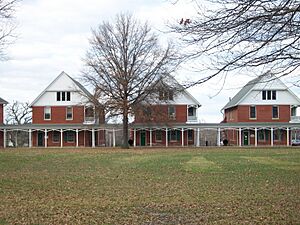Iowa Soldiers' Orphans' Home facts for kids
|
Iowa Soldiers' Orphans' Home
|
|

The main building at the Home
|
|

Location within city
|
|
| Location | 2800 Eastern Ave. Davenport, Iowa |
|---|---|
| Area | 31.9 acres (12.9 ha) |
| Built | 1865 |
| Architect | John W. Ross H.F. Liebbe J. Bradley Rust |
| Architectural style | Classical Revival Queen Anne |
| NRHP reference No. | 82002641 |
Quick facts for kids Significant dates |
|
| Added to NRHP | April 26, 1982 |
The Iowa Soldiers' Orphans' Home, also known as the Annie Wittenmyer Home, was once a special place for children in Davenport, Iowa, United States. It started as an orphanage, a home for children who had lost their parents. Today, it is recognized as a historic place, listed on the Davenport Register of Historic Properties and the National Register of Historic Places.
This home first opened its doors to children whose parents had died or were badly hurt during the American Civil War. Later, starting in 1876, it welcomed children from all 99 counties in Iowa, including those from families facing difficulties.
Contents
History of the Home
How the Home Began
The idea for the home came from a woman named Annie Turner Wittenmyer. She worked as a Sanitation Agent for Iowa during the American Civil War. Her job was to make sure Union Army soldiers from Iowa had what they needed.
During the war, one soldier wrote a letter. He said that while soldiers were thankful for help, they really wanted people to look after their families back home. This letter was read at a meeting, and people decided to create a place for children whose parents were affected by the war. Annie Wittenmyer was a key person on the board that helped make this happen. She worked hard to raise money for the home.
Opening Its Doors
After the Civil War ended, many children in Iowa needed help. More than 13,500 children had lost parents or had parents who were seriously injured. To help these children, an "orphan's fair" was held.
A former soldier camp in Davenport, called Camp Kinsman, was given to be used for the home. On November 11, 1865, the first 150 children arrived by steamboat. Annie Wittenmyer herself was the matron, or head, of the home. The State of Iowa took over the home in June 1866, and Annie Wittenmyer continued to guide it until 1867.
Growing and Changing
As the years passed, the Civil War orphans grew up and left the home. By 1870, the home began to accept children from all over Iowa, not just those affected by the war.
The home grew bigger and changed its design. Instead of large, barrack-style dorms, smaller, more home-like cottages were built. This new design helped keep children safer. Even when fires broke out in 1877, 1880, and 1887, no one was seriously hurt, and the home kept running.
In 1876, a new rule was made: children had to find a job before leaving the home. Also, starting in sixth grade, students spent part of their school day learning a trade. This helped them prepare for life outside the home. By 1890, the home was given legal custody of the children. This allowed them to help place children in good foster or adoptive homes.
The children at the home were also part of the community. In the early 1900s, the Orphans Band marched in parades and gave concerts. Some famous people even lived at the home, like Major League Baseball player Billy Sunday and musician Wayne King.
Later Years and Closure
In 1949, the facility was officially renamed "The Annie Wittenmyer Home" to honor its founder. By 1960, the home's purpose changed. It stopped being a traditional orphanage and became a place for special education and behavioral counseling.
The Annie Wittenmyer Home closed in 1975. It had helped an estimated 12,000 children over more than a century. After it closed, the main Administration Building was used as a branch of the Davenport Public Library from 1976 until 2005.
Historic Area Today
The area where the Annie Wittenmyer Home once stood is now a historic district. This means the buildings and land are important because of their history. It includes many original buildings that were part of the home.
The district is located on the east side of Davenport. It is near Garfield Park and the Duck Creek Parkway. You can also find the graves of some of the children from the home at the nearby Oakdale Memorial Gardens.
Images for kids









